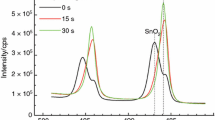Abstract
The chemical reactions between CuSe, SnSe and ZnSe and their enthalpies in molten CdI2 in closed vacuum ampoules were investigated. Differential thermal analysis (DTA) was used for the determination of the temperatures of processes occurring in the studied mixtures. X-ray diffraction and Raman spectroscopy were performed to discover the phase changes in the long-term annealed samples at higher than peak temperatures in DTA. The occurring chemical reactions and their enthalpies were derived. The recrystallization of CZTSe in CdI2 was investigated. The results confirmed the formation of Cu2SnSe3, Cu2SnSe4, CdSe, Cu2CdSnSe4, Cu2ZnSnSe4, and Zn1−xCdxSe compounds and solid solutions.







Similar content being viewed by others
References
Paranthaman MP, Wong-Ng W, Bhattacharya RN. Semiconductor materials for solar photovoltaic cells. Cham: Springer; 2016.
Adachi S. Earth-abundant materials for solar cells: Cu2-II-IV-VI4 Semiconductors. Chichester: Wiley; 2015.
Ito K. Copper zinc tin sulfide-based thin-film solar cells. Chichester: Wiley; 2015.
Kodigala SR. Thin film solar cells from earth abundant materials: growth and characterization of Cu2ZnSn(SSe)4 thin films and their solar cells. London: Elsevier; 2013.
Lee YS, Gershon T, Gunawan O, Todorov TK, Gokmen T, Virgus Y, Guha S. Cu2ZnSnSe4 thin-film solar cells by thermal co-evaporation with 11.6% efficiency and improved minority carrier diffusion length. Adv Energy Mater. 2015. https://doi.org/10.1002/aenm.201401372.
Brammertz G, Buffière M, Oueslati S, ElAnzeery H, Ben Messaoud K, Sahayaraj S, Köble C, Meuris M, Poortmans J. Characterization of defects in 9.7% efficient Cu2ZnSnSe4–CdS–ZnO solar cells. Appl Phys Lett. 2013;103:163904.
Leinemann I, Timmo K, Grossberg M, Kaljuvee T, Tõnsuaadu K, Traksmaa R, Altosaar M, Meissner D. Reaction enthalpies of Cu2ZnSnSe4 synthesis in KI. J Therm Anal Calorim. 2015;119(3):1555–64.
Leinemann I, Zhang W, Kaljuvee T, Tõnsuaadu K, Traksmaa R, Raudoja J, Grossberg M, Altosaar M, Meissner D. Cu2ZnSnSe4 formation and reaction enthalpies in molten NaI starting from binary chalcogenides. J Therm Anal Calorim. 2014;118(2):1313–21.
Leinemann I, Nkwusi GC, Timmo K, Volobujeva O, Danilson M, Raudoja J, Kaljuvee T, Traksmaa R, Altosaar M, Meissner D. Reaction pathway to Cu2ZnSnSe4 formation in CdI2. Part 1 Chemical reactions and enthalpies in mixtures of CdI2–ZnSe, CdI2–SnSe, and CdI2–CuSe. J Therm Anal Calorim. 2018. https://doi.org/10.1007/s10973-018-7102-5.
Wibowo RA, Jung WH, Al-Faruqi MH, Amal I, Kim KH. Crystallization of Cu2ZnSnSe4 compound by solid state reaction using elemental powders. Mater Chem Phys. 2010;124:1006–10.
Klavina I, Raudoja J, Altosaar M, Mellikov E, Meissner D. CZTSe (Cu2ZnSnSe4) crystal growth for use in monograin membrane solar cells. CYSENI 2010. In: Proceeding of the annual conference of young scientists on energy issues. [CD VII-347-VII-353]. Kaunas: Lithuanian Energy Institute. 2010; May 27–28.
Nkwusi G, Leinemann I, Altosaar M. The processes and enthalpies in synthesis of Cu2ZnSnS4 in molten CdI2. IARJSET. 2016;3(5):113–9.
Nkwusi G, Leinemann I, Raudoja J, Mikli V, Kärber E, Altosaar M. Impact of growth-synthesis conditions on Cu2Zn1−xCdxSnS4 monograin material properties. Superlattices Microstruct. 2016;98:400–5.
Software of HSC Chemistry Ver. 6.0. Outoukumpu Research Oy. Pori: Finland.
Ishii M, Shibata K, Nozaki HJ. Anion distributions and phase transitions in CuS1−xSex (x = 0–1) studied by Raman spectroscopy. Solid State Chem. 1993;105:504.
Marcano G, Rincon C, Lopez SA, Perez GS, Herrera-Perez JL, Mendoza-Alvarez JG, Rodriguez P. Raman spectrum of monoclinic semiconductor Cu2SnSe3. Solid State Commun. 2011;151:84–6.
Lucovsky G, Mikkelsen JC, Liang WY, White RM, Martin RM. Optical phonon anisotropies in the layer crystals SnS2 and SnSe2. Phys Rev B. 1976;14:1663–9.
Poborchii VV, Kolobov AV, Tanaka K. An in situ Raman study of polarization-dependent photocrystallization in amorphous selenium films. Appl Phys Lett. 1998;72:1167–9.
Glazov VM, Pashinkin S, Fedorov VA. Phase equilibria in the Cu–Se system. Inorg Mater. 2000;36:641–52.
Chakrabarti DJ, Laughlin DE. The Cu–Se system. Bull Alloy Phase Diagr. 1981;2(3):305–15.
Tomashik VN, Lebrun N, Perrot P. Copper-Selenium-Tin. In: Non-ferrous metal ternary systems. Semiconductor systems: phase diagrams, crystallographic and thermodynamic data. Landolt-Bornstein new series IV/11C1. 2006. p. 361–73.
Blachnik R, Stöter U. The phase diagrams of mixtures of CuI with ZnI2, CdI2, and HgI2. Thermochim Acta. 1989;143:115–22.
Altosaar M, Raudoja J, Timmo K, Danilson M, Grossberg M, Krustok J, Mellikov E. Cu2Zn1−xCdxSn(Se1−ySy)4 solid solutions as absorber materials for solar cells. Phys Stat Sol A. 2008;205:167–70.
Grossberg M, Krustok J, Timmo K, Altosaar M. Radiative recombination in Cu2ZnSnSe4 monograins studied by photoluminescence spectroscopy. Thin Solid Films. 2009;517:2489–92.
Dudchak IV, Piskach LV. Phase equilibria in the Cu2SnSe3–SnSe2–ZnSe system. J Alloy Compd. 2003;351:145–50.
Redkin A, Korzun I, Reznitskikh O, Yaroslavtseva T, Zaikov Y, Kumkov S. Heat of fusion of halide salts and their eutectics. J Therm Anal Calorim. 2017. https://doi.org/10.1007/s10973-017-6650-4.
Redkin A, Korzun I, Yaroslavtseva T, Reznitskikh O, Zaikov Y. Isobaric heat capacity of molten halide eutectics. J Therm Anal Calorim. 2017;128:621. https://doi.org/10.1007/s10973-016-5869-9.
Acknowledgements
We sincerely appreciate the experimental support with the apparatus provided for XRD and DTA measurements by the heads of the Department of Mechanical and Industrial Engineering and Laboratory of Inorganic Materials. We acknowledge the following projects for their financial support: TAR16016 “Advanced materials and high-technology devices for sustainable energetics, sensorics and nanoelectronics”; IUT19-28 “New materials and technologies for solar energetics”.
Author information
Authors and Affiliations
Corresponding author
Rights and permissions
About this article
Cite this article
Leinemann, I., Pilvet, M., Kaljuvee, T. et al. Reaction pathway to CZTSe formation in CdI2. J Therm Anal Calorim 134, 433–441 (2018). https://doi.org/10.1007/s10973-018-7415-4
Received:
Accepted:
Published:
Issue Date:
DOI: https://doi.org/10.1007/s10973-018-7415-4




